Lorna Rees, Artistic Director, Gobbledegook Theatre
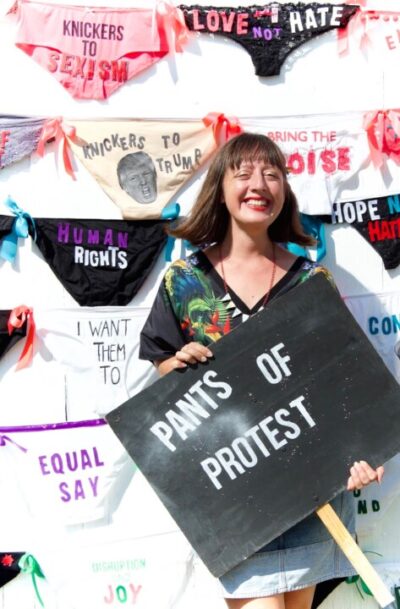
Lorna Rees
Lorna talks about her amazing work in the Outdoor Arts sector, from early days of thriving in the public realm to the inspiration of Areas of Outstanding Natural Beauty. Not to mention, gazing at clouds and creative activism. (First published: January 2019).
How did you first get involved in Outdoor Arts?
As a young teen I used to go to a drama club and our teacher recommended that I join the local outdoor Shakespeare Company who staged productions in Christchurch. I used to sit backstage under the trees and stare up at the sky and think that this was exactly where I wanted to be. It was a rather traditional type of performance, but those early days gave me a great deal of technical understanding of outdoor theatre: from lighting outdoors, to building the set, through to the technical ability to project my voice (which still comes in handy!). Community and amateur theatre is an amazing training ground and I owe them a lot.
I went to the Central School of Speech and Drama and studied what is now called the Applied Theatre course – it was an intensely practical and academic three years and we had the opportunity to make work for the outdoors at the Minack Theatre in our first year. I realised that not everyone felt entirely at home working in that space, or in the public realm, whereas I absolutely thrived on it.
For my third year at Central, I directed a piece of punk Commedia Dell’Arte on the fire escapes up the side of the main building, turned our Senior Lecturer’s office into a brothel and had several large bins of fire lighting the piece. I knew that was the kind of work I wanted to make. My partner, Adam Coshan (who set up Gobbledegook with me) also went to Central and we were both heavily influenced by the politics and community-building work of John Fox, Sue Gill and Welfare State International.
What is one of your earliest memories of Outdoor Arts?
Although I grew up mainly in Dorset, my family originally came from Harlow in Essex. As a new town they’d invested heavily in public art – I reckon all those Henry Moores must have had an effect somewhere along the way. In Harlow town park there were often big open-air free gigs, and my parents would take us to them. My sister and I would get taken to lots of gigs and outdoor events as children, and so I think that the idea of communally watching music is certainly special for both of us. I vaguely remember a lantern parade somewhere and a Glastonbury light up carnival.
My Dad used to work on the fruit and veg market stalls around East London and Harlow. Calling on a stall is a very performative job – so I think somewhere along the way I get the desire to perform from him. On my mum’s side, I’m from a family of makers and dresser-uppers. My Grandad is an engineer who still advises me on all my builds, and my mum is a professional seamstress. I’d say my intense desire to make and design is certainly inherited from them.
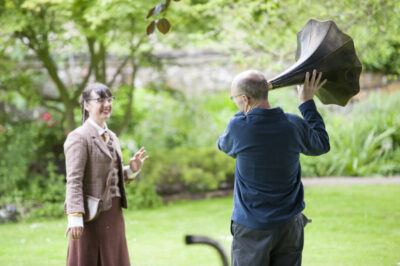 What performances or Outdoor Arts experiences have made a big impression on you?
What performances or Outdoor Arts experiences have made a big impression on you?
In the first year I was involved in Inside Out Dorset in 2007, I particularly remember how incredibly beautiful Red Earth’s site-specific piece on Hambledon Hill was, and Periplum’s amazing (and chilling) Arquiem in Wimborne Minster. It was relatively easy to be wowed and spoilt for choice by great spectacle in London, but seeing such extraordinary things in rural Dorset was, and still is, pretty thrilling.
Around 15 years ago, when I was still living in London, I saw Hoodwink’s Gastronomic as part of the National Theatre’s ‘Watch This Space’ programme. At the time I was working in indoor theatre as Education and Community Manager for Greenwich Theatre. It was such a joyful and silly and wonderful whimsical piece. It definitely made me think that I’d like to do what they’re doing…. Years and years later, completely coincidentally, Stephanie cast me in a Hoodwink show on Brownsea Island, which was so rewarding an experience it essentially led to me giving up my day job as a theatre producer. I’m lucky now that Stephanie Jalland (who runs Hoodwink) is a friend and that experience on Brownsea really gave me the confidence to be a full-time artist.
What’s the best artistic advice you’ve been given?
Why are you making a piece of artwork?
I used to work at the Royal Court Theatre in London, (I was lucky enough to work closely with Simon Stephens on writing projects), and we were always asking new playwrights to think about why they were writing something – what is the point in saying it? What drives you to say it? It’s a different and more pertinent question to asking what a play or a show is about. I still think it’s great advice. It works for me at least!
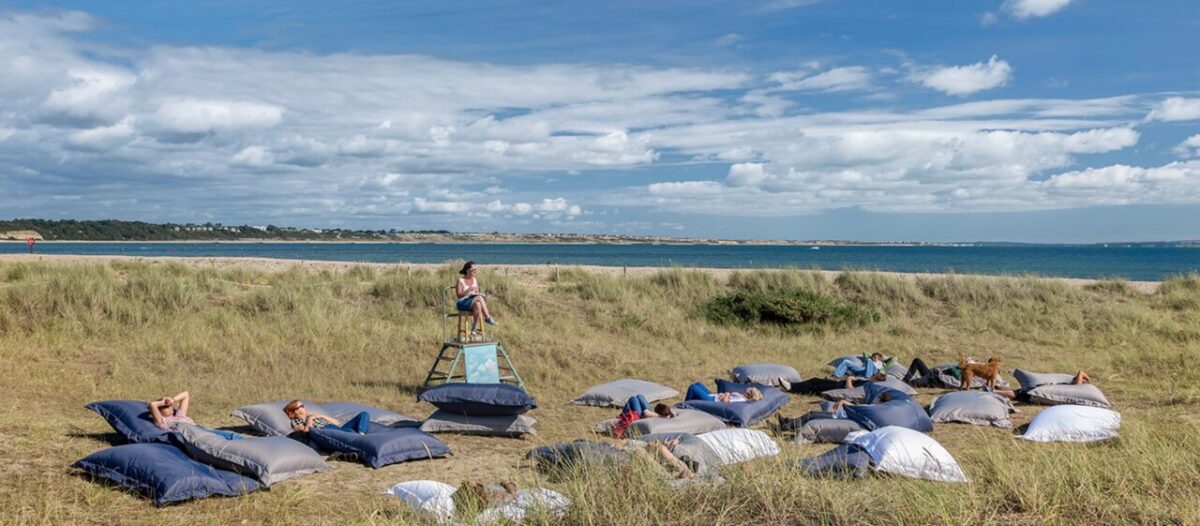
Where do your ideas come from?
For my larger pieces, I’m incredibly inspired by landscape, particularly where I live in Dorset. We’re in the South Dorset Ridgeway AONB and I’ve worked as Artist in Residence for the Jurassic Coast Trust World Heritage Site. All of my larger works are inspired by Earth Sciences – weather and geology. I love walking on the coastline or in the New Forest, both of which are really near to where I live.
For my smaller works, the quick immediate stuff, or small interventions I make for music festivals, I have a thread of what I call Disruption and Joy. It often encompasses activism and politically inspired actions, but might also include making work with young people or taking over a university campus for the day.
What’s your funniest or most bizarre Outdoor Arts experience?
There are too many to count! It’s my favourite thing though, the brilliant and the bizarre conversations you have when you’re working outdoors. The kind of work I make is very interactive, and the randomness and glorious oddness of people everywhere is one of the very best things about it.
Many years ago now, my own (at the time very young and close in age) kids staged a pitch invasion when I was performing the last scene of a children’s show at Camp Bestival. They’d not quite got the hang of rehearsal space and performance space being different things, had given their designated carer the slip and completely ignored the ‘law of the rope’ when it meant not getting to their mum. I was utterly mortified but had to finish the performance carrying my two toddlers. Although I seem to remember that the audience rather loved it.
In geological terms, I remember a moment at the Devises International Street Festival when a sinkhole opened up and Mike Imerson (Dizzy O’Dare) rather gamely jumping inside the hole. That was pretty bizarre…
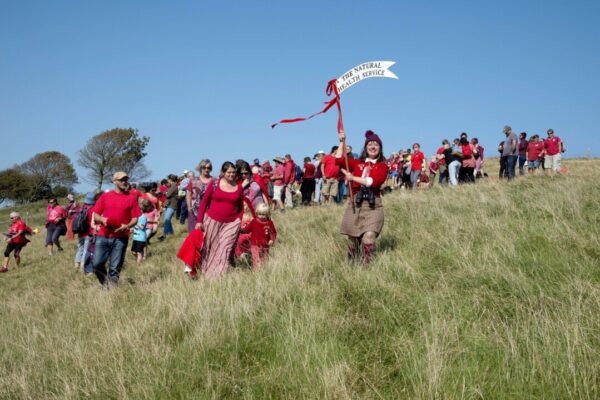 Describe a current project or future piece of work that you’re really excited about.
Describe a current project or future piece of work that you’re really excited about.
I’m working hard on a new piece called Geophonic – it’s all about listening to geological processes. It’s been brewing for nearly two years so I’ve had a good gestation time.
I was supported in going to Sri Lanka on the Sura Medura Arts Residency for six weeks late last year by Activate Performing Arts who run the Inside Out Dorset Festival to work on Geophonic, and I’m really excited about what it’s going to become. I work a lot with music and sound and these will definitely play a large part in this new piece.
Who inspires you in your work?
I work a lot with scientists and specialists when I make my work, so those relationships are the ones I get particularly excited about. In the past couple of years, I’ve had the great pleasure to work with Dr Anjana Khatwa Ford and Sam Scriven. Both are Earth Scientists who work with the Jurassic Coast Trust and they’re two of the best and most passionate science communicators you could ever hope to meet.
I also have a fantastic group of frequent company collaborators, including Adele Keeley, Heidi Steller, Mark Bishop, Jonny Croose and Kate McStraw who inspire me greatly.
How do you follow what’s happening in the Outdoor Arts and cultural sectors? What blogs, tweeters, websites and organisations do you recommend?
I probably follow more scientists, politicians and activists on Twitter than I do arts organisations, although these aren’t mutually exclusive categories. I really like what Michelle Walker tweets, @michelleyascapi, as well as seeing what Toby Smith is seeing next, @_toby_smith.
Obviously, everyone should be following @OutdoorArtsUK , @OutdoorArtsPRO and @XtraxArts, which are invaluable.
@TotalTheatreMag is brilliant and Dorothy Max Prior is such an incredible champion of work which isn’t necessarily in the mainstream. You can look at the magazine itself here: http://totaltheatre.org.uk. We are so lucky to have them.
I read Arts Professional which is useful for cultural sector stuff, and I bought an annual subscription to The Stage when Lyn Gardner started writing for them. It’s a paper I haven’t looked at for many, many years and perhaps it’s a terrible admission, but now I rather like how gossipy it is. There’s very occasionally some decent industry stuff in there, but I mainly think of it as being a bit like ‘Heat’ for theatre nerds.
What non-Outdoor Arts performance has made a great impression on you?
I saw Lindsay Kemp’s Variete when I was 17 and it was a sort of light-bulb moment – extraordinarily visually stunning!
I used to go to Duckie at the RVT when I first moved to London in my late teens and the playfulness (and total unabashed joy) has stayed with me far longer than many more serious or ‘worthy’ works of art. I felt like I’d found where I was always meant to be. I was never brave enough to perform there, but its influence has been long-lasting.
Name a great book, film, concert or other cultural experience that you’ve enjoyed in the past couple of years…
Victoria Melody’s Ugly Chief was brilliant. We were both presenting work at the Caravan Showcase at the Brighton Festival and we’d both made shows about our relationships with our fathers (and their mortality). Despite the similarities in subject matter, the shows we’d made were utterly different. Mine is called Cloudscapes and it’s a contemplative solo outdoor work about driving across America with my Dad, cloudspotting on Route 66 (the audience lie on giant beanbags and watch clouds as I talk to them), whereas Vic’s show is a hilarious indoor piece with a live band about arranging her own Dad’s funeral after he was given a short amount of time to live. Anyway, I thought Vic’s show was utterly beautiful, very funny and tender. She’s smashing.
I was also involved in the Women’s International March/Anti-Trump rally in July. I’d made a political protest with some of my knickers against my local MP concerning him blocking the upskirting bill which then went viral. I was subsequently invited to create the scenography for the stage in Parliament Square at the ‘Bring The Noise’ march. In terms of a cultural experience, it was pretty fantastic. I grinned all day.
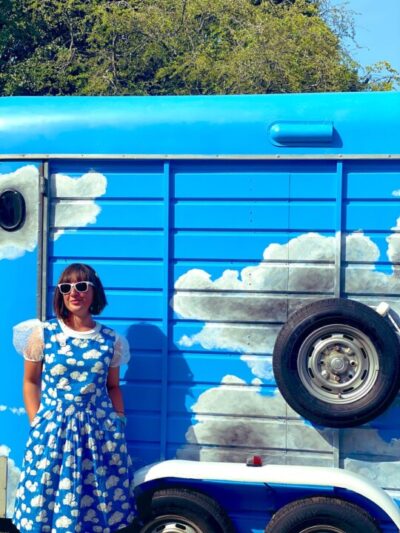 Who would you have at your dream picnic? Pick 3-5 people (living/dead/real/fictional)…
Who would you have at your dream picnic? Pick 3-5 people (living/dead/real/fictional)…
I know you’re not really meant to meet your heroes, but I think that on balance I’d probably really like to. So I’d have: William Smith, the ‘Father of English Geology’ (b.1769 –d.1839); Luke Howard, early Meteorogist and namer of clouds (b.1772 – d.1864); Gertrude Bell, Archeologist, politician and writer (b. 1868 – d.1926); Mary Anning, early, and brilliant, Paleontologist (b.1799 – d.1847); and Joss Whedon, um, creator of Buffy the Vampire Slayer (b. 1964).
I do hope that they all get on.
What are your top tips for someone wanting to work outdoors for the first time?
I think that I learnt a lot about audiences and their behaviour from busking. I also remember reading the Bim Mason book – ‘Street Theatre and Other Outdoor Performance’ as an undergraduate and it really inspired me.
GO AND SEE loads of stuff. One of the best things about this sector is how multidisciplinary it is, and talk to other people in the Outdoor Arts – the vast majority of them are really collaborative, generous and genuinely kind.
Weatherproof your costumes.


